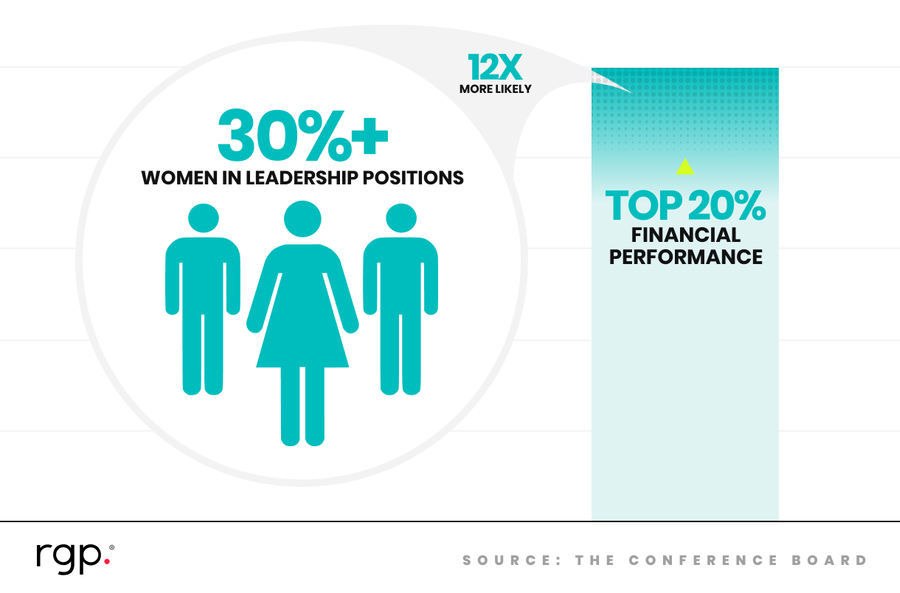February 18 • 4 Min Read
The increasing presence of women in leadership roles is an example of the kind of change we are seeing in an era defined by rapid transformation. According to Pew Research1, female CEOs at Fortune 500 companies reached a record 10.6% in 2023, falling slightly to 10.4 in 2024. Women now comprise 29% of C-suite positions, up from 15% in 2017.
I worry about the pace of change. Despite women filling more leadership roles today, the gender gap is still too wide, and progress is too slow. McKinsey’s 2024 Women in the Workplace report indicates that while women have made gains at every level of the corporate pipeline, the journey to parity remains fraught with obstacles. Women of color, in particular, face significant barriers, with only 7% of C-suite positions held by this group.
Women Leaders Bring Unique Strengths to the C-Suite
In 2005, addressing gender disparity was established by the United Nations as a Sustainable Development Goal (SDG) for the 2030 agenda. As Li Junhua, United Nations Under-Secretary-General for Economic and Social Affairs, wrote in a recent report, “The costs of inaction on gender equality are immense, and the rewards of achieving it are far too great to ignore. We can only achieve the 2030 Agenda with the full and equal participation of women and girls in every part of society.”
Addressing gender disparity in the C-suite is a subset of the much-needed change Junhua highlights, and it is essential for building a more innovative workforce. Research consistently shows that women leaders bring unique strengths to the table, including enhanced creativity, empathy, and collaborative skills. These attributes are vital for the bold decision-making and cultivation of new ideas demanded by today’s complex business environment.
The costs of inaction on gender equality are immense, and the rewards of achieving it are far too great to ignore. We can only achieve the 2030 Agenda with the full and equal participation of women and girls in every part of society.
– Li Junhua, United Nations Under-Secretary-General for Economic and Social Affairs
Digital transformation is expected to grow by a factor of almost 10 between 2023 and 2035, according to Precedence Research, from a $943.97 billion market to $9.15 trillion. This growth underscores the need for diverse leadership capable of navigating such rapid and dynamic changes effectively.
Many jobs will be highly impacted—some to the point of obsolescence—by AI. Others will require learning new skills and high degrees of flexibility and adaptability. Managing workers under such circumstances will demand strong communication skills, increased teamwork and adaptability—among the attributes at which women leaders excel.
Gender Diversity at the Leadership Level Boosts the Bottom Line
Research from The Conference Board reveals a compelling correlation between gender diversity in leadership and financial performance. Organizations with at least 30% women in leadership positions are 12 times more likely to rank in the top 20% for financial performance. This statistic underscores the significant impact that diverse leadership can have on a company’s success.

Companies with women in leadership positions are also increasingly attractive to investors, as research shows that diverse teams often deliver stronger financial returns. For example, a report by MSCI found that firms with strong female leadership generated a return on equity of 10.1% per year, compared to 7.4% for those without.
The bottom line is clear: organizations that embrace gender diversity in leadership not only enhance their financial performance but also position themselves for long-term success in an increasingly competitive landscape. By prioritizing women in leadership roles, companies can unlock significant economic benefits while fostering a culture of inclusivity and resilience.
It’s hardly surprising that according to a report from the 2025 World Economic Forum in Davos, “…Women are considered the highest priority group for surveyed employers’ diversity, equity and inclusion programmes worldwide, with 76% of respondents anticipating a focus of their measures on this group.”
Half the world’s talent is left untapped, and we cannot make progress on gender equality—or any other issues—unless women can achieve their full potential.
– Anita Zaidi, President, Gender Equality at The Gates Foundation
Investing in Success: A Diverse Workforce
Achieving meaningful change requires a continuous commitment to recognizing the value of diverse leaders and investing in their development. It remains crucial for organizations across all industries to prioritize diversity in leadership. By fostering an inclusive environment, industry leaders can unlock the full potential of their teams to drive innovation that meets the challenges of tomorrow.
C-suite leaders, boards and investors can all play a role in championing the unique contributions of women in leadership roles to create a more equitable and successful business landscape.
I believe closing the gender gap is about more than just business success. We should heed the words of Anita Zaidi, president, Gender Equality at The Gates Foundation: “Half the world’s talent is left untapped, and we cannot make progress on gender equality—or any other issues—unless women can achieve their full potential. From healthcare and business to public office and the courts, women are underrepresented and undervalued. Yet women’s representation in leadership positions has significant implications for health, justice, and prosperity for everyone.”
A version of this article appeared on Forbes.
1 Pew Research: The Data on Women Leaders, Sept. 27, 2023

